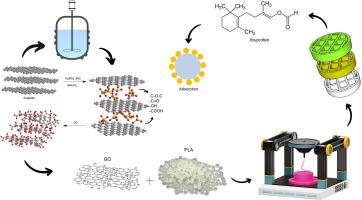Application of three-dimensional structures of polylactic acid (PLA) impregnated with graphene oxide for adsorption of ibuprofen
IF 6.7
2区 工程技术
Q1 ENGINEERING, CHEMICAL
引用次数: 0
Abstract
Growing environmental concerns are driving the development of sustainable engineering solutions. In this scenario, 3D printing and nanomaterials, like graphene oxide (GO), stand out. 3D printing enables layer-by-layer fabrication, often using polylactic acid (PLA), a biodegradable polymer. Meanwhile, nanomaterials, especially carbon-based structures, show great potential in adsorption processes due to their unique physicochemical properties.
This study developed a composite material of 1 % (w/w) GO in PLA, processed by 3D printing, for the removal of ibuprofen (IBP), dipyrone, and chloroquine. The support showed good performance with the removal of IBP, a common pharmaceutical contaminant in water. Graphene oxide, with its large surface area and negative charge, is a highly effective adsorbent. Batch tests under optimal adsorption conditions demonstrated that the composite removed up to 70 % of IBP with an adsorption capacity of 14.6 mg.g−1 within 30 min, at a pH of 2, knowing that its pKa is 4.91, for improvement, in the isotherm with a temperature adjustment to 45 °C, this capacity increased to 25.9 mg.g−1, proving its strong adsorption capability.
These results underscore the potential of the GO+PLA composite as a sustainable and efficient adsorbent. Integrating nanotechnology with additive manufacturing paves the way for environmentally friendly water treatment solutions, contributing to greener, more sustainable environmental technologies.

氧化石墨烯浸渍聚乳酸(PLA)三维结构吸附布洛芬的研究
日益增长的环境问题正在推动可持续工程解决方案的发展。在这种情况下,3D打印和纳米材料,如氧化石墨烯(GO)脱颖而出。3D打印可以实现逐层制造,通常使用聚乳酸(PLA),一种可生物降解的聚合物。同时,纳米材料,特别是碳基结构,由于其独特的物理化学性质,在吸附过程中显示出巨大的潜力。本研究开发了一种复合材料,在PLA中添加1% (w/w)的氧化石墨烯,通过3D打印处理,用于去除布洛芬(IBP)、双吡酮和氯喹。该载体对水中常见的药物污染物IBP有较好的去除效果。氧化石墨烯具有较大的表面积和负电荷,是一种高效的吸附剂。在最佳吸附条件下的批量试验表明,在pH = 2的条件下,该复合材料的吸附量为14.6 mg.g - 1,在30 min内可去除70%的IBP,其吸附量为14.6 mg.g - 1,而在pKa为4.91的情况下,在等温线上,将其温度调节到45℃,吸附量增加到25.9 mg.g - 1,证明了其较强的吸附能力。这些结果强调了氧化石墨烯+聚乳酸复合材料作为可持续和高效吸附剂的潜力。纳米技术与增材制造的结合为环保的水处理解决方案铺平了道路,为更绿色、更可持续的环境技术做出了贡献。
本文章由计算机程序翻译,如有差异,请以英文原文为准。
求助全文
约1分钟内获得全文
求助全文
来源期刊

Journal of water process engineering
Biochemistry, Genetics and Molecular Biology-Biotechnology
CiteScore
10.70
自引率
8.60%
发文量
846
审稿时长
24 days
期刊介绍:
The Journal of Water Process Engineering aims to publish refereed, high-quality research papers with significant novelty and impact in all areas of the engineering of water and wastewater processing . Papers on advanced and novel treatment processes and technologies are particularly welcome. The Journal considers papers in areas such as nanotechnology and biotechnology applications in water, novel oxidation and separation processes, membrane processes (except those for desalination) , catalytic processes for the removal of water contaminants, sustainable processes, water reuse and recycling, water use and wastewater minimization, integrated/hybrid technology, process modeling of water treatment and novel treatment processes. Submissions on the subject of adsorbents, including standard measurements of adsorption kinetics and equilibrium will only be considered if there is a genuine case for novelty and contribution, for example highly novel, sustainable adsorbents and their use: papers on activated carbon-type materials derived from natural matter, or surfactant-modified clays and related minerals, would not fulfil this criterion. The Journal particularly welcomes contributions involving environmentally, economically and socially sustainable technology for water treatment, including those which are energy-efficient, with minimal or no chemical consumption, and capable of water recycling and reuse that minimizes the direct disposal of wastewater to the aquatic environment. Papers that describe novel ideas for solving issues related to water quality and availability are also welcome, as are those that show the transfer of techniques from other disciplines. The Journal will consider papers dealing with processes for various water matrices including drinking water (except desalination), domestic, urban and industrial wastewaters, in addition to their residues. It is expected that the journal will be of particular relevance to chemical and process engineers working in the field. The Journal welcomes Full Text papers, Short Communications, State-of-the-Art Reviews and Letters to Editors and Case Studies
 求助内容:
求助内容: 应助结果提醒方式:
应助结果提醒方式:


